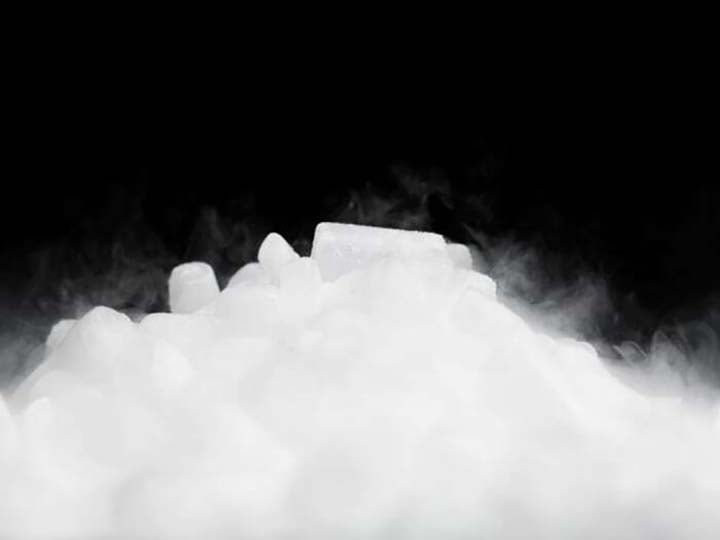Barafu kavu ni aina imara ya kaboni dioksidi (CO2) ambayo hutumiwa mara nyingi katika matumizi mbalimbali, ikiwa ni pamoja na uhifadhi wa chakula, majaribio ya kimatibabu na kisayansi, na athari maalum katika burudani. Tofauti na barafu ya kawaida, barafu kavu huyeyuka lakini badala yake hupungua (hupita moja kwa moja kutoka hali imara hadi gesi) kwa joto la -109.3°F (-78.5°C). Hii huifanya kuwa chaguo bora kwa matumizi ambapo mabadiliko ya haraka kutoka hali imara hadi gesi yanahitajika, na pia kwa matumizi ambapo barafu ya kawaida haitafaa kutokana na kiasi cha nafasi inayohitajika kwa ajili ya kuhifadhi.
Barafu kavu ni nini
Barafu kavu ni aina ngumu ya dioksidi kaboni (CO2) inayotumika kwa kupoeza na kuhifadhi. Tofauti na barafu ya kawaida, barafu kavu haina kuyeyuka, inapunguza moja kwa moja kwenye gesi. Barafu kavu ni baridi zaidi kuliko barafu ya kawaida na hutumiwa kwa matumizi anuwai ya kupoeza. Walakini, ni baridi sana na inaweza kusababisha baridi ikiwa inaguswa na ngozi iliyo wazi, kwa hivyo ni lazima ishughulikiwe kwa tahadhari.

Jinsi ya kutengeneza barafu kavu nyumbani
Ikiwa ungependa kutengeneza barafu kavu nyumbani, hapa kuna mwongozo wa hatua kwa hatua kukusaidia kuanza:
Hatua ya 1: Pata usambazaji wa gesi ya kaboni dioksidi (CO2).
Hatua ya kwanza katika kutengeneza barafu kavu ni kupata usambazaji wa gesi ya kaboni dioksidi. Gesi ya CO2 inaweza kununuliwa kutoka kwa wauzaji wanaobobea katika utengenezaji na uuzaji wa barafu kavu. Hakikisha umechagua mtoa huduma anayeaminika ambaye anaweza kukupa ubora wa juu, aina safi ya gesi ya CO2.
Hatua ya 2: Finyaza gesi ya kaboni dioksidi
Mara tu unapopata usambazaji wa gesi ya CO2, hatua inayofuata ni kuibana kwa kutumia mashine inayojulikana kama compressor. Hii itaongeza shinikizo la gesi, na kusababisha kuunganishwa kwa fomu imara. Vipimo halisi vya compressor vitatofautiana kulingana na kiasi cha gesi ya CO2 unayotaka kukandamiza, lakini kwa ujumla, utataka compressor ambayo inaweza kufikia shinikizo la angalau 800 psi.
Hatua ya 3: Poza gesi ya kaboni dioksidi iliyobanwa
Hatua inayofuata ni kupoza gesi ya kaboni dioksidi iliyobanwa hadi joto la -109.3°F (-78.5°C). Hii inaweza kufanywa kwa kutumia mfumo maalum wa kupoeza ambao umeundwa kufikia joto linalohitajika. Ufafanuzi halisi wa mfumo wa baridi utategemea kiasi cha gesi ya CO2 unayotaka kupoa na hali ambayo utafanya kazi.
Hatua ya 4: Hifadhi barafu kavu
Mara tu gesi ya CO2 iliyobanwa imepozwa hadi joto linalohitajika, itabadilika kutoka gesi hadi kuwa ngumu, na kutengeneza barafu kavu. Barafu kavu inapaswa kuhifadhiwa katika eneo lenye uingizaji hewa mzuri, kwani itazama (kuyeyuka) katika gesi ya CO2 kwa kiwango cha takriban pauni tano hadi kumi kwa siku.
Mazingatio ya Usalama
Ni muhimu kushughulikia barafu kavu kwa tahadhari, kwani ni baridi sana na inaweza kusababisha baridi ikiwa inagusana moja kwa moja na ngozi. Ili kuepuka kuumia, daima kuvaa glavu za kinga au kutumia koleo wakati wa kushughulikia barafu kavu. Zaidi ya hayo, barafu kavu inaweza kuwa hatari ikiwa itahifadhiwa katika nafasi iliyofungwa, kwani mchakato wa usablimishaji utatoa gesi ya CO2 angani. Ili kuepuka hatari ya kukosa hewa, hakikisha kuhifadhi barafu kavu kwenye eneo lenye uingizaji hewa mzuri.
Je, ni sawa ukigusa barafu kavu?
Hapana, si salama kugusa barafu kavu na ngozi tupu. Barafu kavu ni baridi sana na inaweza kusababisha baridi, ambayo ni aina ya jeraha kwa ngozi na tishu za msingi. Kugusa barafu kavu kunaweza kusababisha maumivu na uwekundu, na vile vile majeraha makubwa zaidi, kama vile malengelenge, kufa ganzi, na katika hali mbaya, uharibifu wa tishu. Ili kuepuka kuumia, daima kuvaa glavu za kinga au kutumia koleo wakati wa kushughulikia barafu kavu. Ikiwa unagusana na barafu kavu, ni muhimu kuosha eneo lililoathiriwa na maji ya joto ili kuzuia baridi.

Barafu kavu itadumu kwa muda gani?
Urefu wa muda ambao barafu kavu itadumu inategemea mambo kadhaa, ikiwa ni pamoja na hali ya joto na unyevu wa mazingira inapohifadhiwa, ukubwa na unene wa vipande, na aina ya chombo kinachohifadhiwa. Kwa ujumla, barafu kavu. itadumu popote kuanzia saa 24 hadi 48 kwenye chombo chenye maboksi. Hata hivyo, muda wa barafu kavu itadumu unaweza kuwa mrefu au mfupi kulingana na hali maalum.
Ili kuongeza muda wa maisha wa barafu kavu, inapaswa kuhifadhiwa kwenye chombo kilichohifadhiwa vizuri, kama vile baridi ya Styrofoam, na kuwekwa mahali pa baridi, kavu mbali na jua moja kwa moja na vyanzo vingine vya joto. Zaidi ya hayo, kifuniko cha chombo kinapaswa kufungwa vizuri ili kupunguza kasi ya mchakato wa usablimishaji na kuzuia kutolewa kwa gesi ya CO2.
Kwa kumalizia, maisha ya barafu kavu hutofautiana, lakini kwa ujumla ni kati ya masaa 24 na 48. Hifadhi ifaayo katika chombo chenye maboksi ya kutosha na mazingira ya baridi na kavu yanaweza kusaidia kupanua maisha yake.
Hitimisho
Kufanya barafu kavu nyumbani inaweza kuwa mradi wa kujifurahisha na wa elimu, lakini ni muhimu kufuata hatua zilizoelezwa hapo juu na kuchukua tahadhari muhimu za usalama ili kuhakikisha kwamba mchakato unafanywa kwa usalama na kwa mafanikio. Iwe unatumia barafu kavu kuhifadhi chakula, majaribio ya kisayansi, au madoido maalum, utaona kuwa nyenzo hii inayoamiliana hutoa anuwai ya programu zinazowezekana na inaweza kukupa fursa nyingi za kujieleza kwa ubunifu na uchunguzi.
Shuliy Machinery ni mtengenezaji mkuu wa mashine za barafu kavu nchini China. Tuna uzoefu mkubwa katika utafiti, usanifu, utengenezaji, na usambazaji wa mashine mbalimbali za barafu kavu, kama vile mashine ya kutengeneza barafu kavu, mashine ya kulipua barafu kavu, mashine ya kutengeneza vipande vya barafu kavu, mashine ya kutengeneza vipande vikubwa vya barafu kavu, n.k. Ikiwa unataka kuanzisha biashara yako ya kutengeneza barafu kavu ya viwandani, wasiliana nasi kwa maelezo zaidi.

